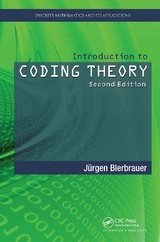
Introduction to Coding Theory
Chapman & Hall/CRC (Verlag)
978-1-58488-421-7 (ISBN)
- Titel erscheint in neuer Auflage
- Artikel merken
Although its roots lie in information theory, the applications of coding theory now extend to statistics, cryptography, and many areas of pure mathematics, as well as pervading large parts of theoretical computer science, from universal hashing to numerical integration.
Introduction to Coding Theory introduces the theory of error-correcting codes in a thorough but gentle presentation. Part I begins with basic concepts, then builds from binary linear codes and Reed-Solomon codes to universal hashing, asymptotic results, and 3-dimensional codes. Part II emphasizes cyclic codes, applications, and the geometric desciption of codes. The author takes a unique, more natural approach to cyclic codes that is not couched in ring theory but by virtue of its simplicity, leads to far-reaching generalizations. Throughout the book, his discussions are packed with applications that include, but reach well beyond, data transmission, with each one introduced as soon as the codes are developed.
Although designed as an undergraduate text with myriad exercises, lists of key topics, and chapter summaries, Introduction to Coding Theory explores enough advanced topics to hold equal value as a graduate text and professional reference. Mastering the contents of this book brings a complete understanding of the theory of cyclic codes, including their various applications and the Euclidean algorithm decoding of BCH-codes, and carries readers to the level of the most recent research.
Part I: AN ELEMENTARY INTRODUCTION TO CODING
THE CONCEPT OF CODING
Bitstrings and Binary Operations
The Hamming Distance
Binary Codes
Error-Correcting Codes in General
The Binary Symmetric Channel
The Sphere-Packing Bound
BINARY LINEAR CODES
The Concept of Binary Linear Codes
Block Coding
The Effect of Coding
Duality
Binary Hamming and Simplex Codes
Principle of Duality
GENERAL LINEAR CODES
Prime Fields
Finite Fields
Linear Codes Over Finite Fields
Duality and Orthogonal Arrays
Weight Distribution
The Game of Set
Syndrome Decoding
REED-SOLOMON CODES
RECURSIVE CONSTRUCTION I
UNIVERSAL HASHING
DESIGNS AND THE BINARY GOLAY CODE
SHANNON ENTROPY
ASYMPTOTIC RESULTS
3-DIMENSIONAL CODES, PROJECTIVE PLANES
SUMMARY AND OUTLOOK
Part II: THE THEORY OF CODES AND THEIR APPLICATIONS
SUBFIELD CODES AND TRACE CODES
The Trace
Trace Codes and Subfield Codes
Galois Closed Codes
Automorphism Groups
CYCLIC CODES
Some Primitive Cyclic Codes of Length 15
Theory of Cyclic Codes
Decoding BCH-Codes
Constacyclic Codes
Remarks
RECURSIVE CONSTRUCTIONS, COVERING RADIUS
Construction X
Covering Radius
OA IN STATISTICS AND COMPUTER SCIENCE
OA and Independent Random Variables
Linear Shift Register Sequences
Cryptography
Two-Point Based Sampling
Resilient Functions
Derandomization of Algorithms
Authentication and Universal Hashing
THE GEOMETRIC DESCRIPTION OF CODES
Linear Codes as Sets of Points
Quadratic Forms, Bilinear Forms and Caps
Caps: Constructions and Bounds
ADDITIVE CODES
Basic Constructions and Applications
Additive Cyclic Codes
Quantum Codes
THE LAST CHAPTER
The Linear-Programming Bound
Algebraic-Geometric Codes
List Decoding
Expander Codes
tms-Nets
Sphere Packings
Designs
Nonlinear Codes
REFERENCES
| Erscheint lt. Verlag | 17.8.2004 |
|---|---|
| Reihe/Serie | Discrete Mathematics and Its Applications |
| Zusatzinfo | 1000 equations; 19 Illustrations, black and white |
| Sprache | englisch |
| Maße | 156 x 234 mm |
| Gewicht | 703 g |
| Themenwelt | Mathematik / Informatik ► Informatik ► Theorie / Studium |
| ISBN-10 | 1-58488-421-5 / 1584884215 |
| ISBN-13 | 978-1-58488-421-7 / 9781584884217 |
| Zustand | Neuware |
| Haben Sie eine Frage zum Produkt? |
aus dem Bereich



